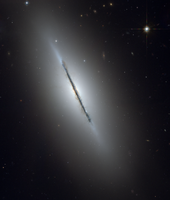
Photo from wikipedia
The change of the total mass density slope, γ, of early-type galaxies through cosmic time is a probe of evolutionary pathways. Hydrodynamical cosmological simulations show that at high redshifts density… Click to show full abstract
The change of the total mass density slope, γ, of early-type galaxies through cosmic time is a probe of evolutionary pathways. Hydrodynamical cosmological simulations show that at high redshifts density profiles of early-type galaxies were on average steep (γ ∼ −3). As redshift approaches zero, gas-poor mergers progressively cause the total mass density slope to approach the ‘isothermal’ slope of γ ∼ −2. Simulations therefore predict steep density slopes at high redshifts, with little to no evolution in density slopes below z ∼ 1. Gravitational lensing results in the same redshift range find the opposite, namely a significant trend of shallow density slopes at high redshifts, becoming steeper as redshift approaches zero. Gravitational lensing results indicate a different evolutionary mechanism for early-type galaxies than dry merging, such as continued gas accretion or off-axis mergers. At redshift zero, isothermal solutions are obtained by both simulations and dynamical modelling. This work applies the Jeans dynamical modelling technique to observations of galaxies at intermediate redshifts (0.29 < z < 0.55) in order to derive density slopes to address the tension between observations and simulations. We combine two-dimensional kinematic fields from MUSE data with Hubble Space Telescope photometry. The density slopes of 90 early-type galaxies from the Frontier Fields project are presented. The total sample has a median of γ = −2.11 ± 0.03 (standard error), in agreement with dynamical modelling studies at redshift zero. The lack of evolution in total density slopes in the past 4-6 Gyrs supports a dry merging model for early-type galaxy evolution.
Journal Title: Monthly Notices of the Royal Astronomical Society
Year Published: 2021
Link to full text (if available)
Share on Social Media: Sign Up to like & get
recommendations!